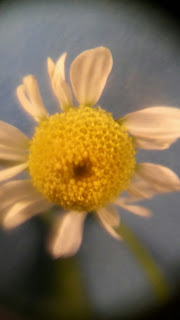We had a garden chrysanthemum for comparison, but again there is uncertainty. There are many cultivars of the garden flower and some possible hybrids in the woodland flower. The true central flowers appear some what different the garden flower being concave and the woodland flower convex. This could be a different stage in maturity. The inferior calyx is different with the longer tighter green sepals on the woodland flower. After a detailed dichotomous key analysis the woodland plant did seem to be more like the feverfew than the cultivated plant.
There is little science behind using feverfew for actual fevers, but it has been used as a treatment for migraine. the active agent is parthenolide. The cultured varieties also have chemical activity ,an insecticide with the active agent being pyrethrin. There is no clear analysis of which variety has the medical benefit, which has the insecticide or how the two merge into one another. The commercial interest focus on either migraine or the insect repellant not both, and they may be totally separate.
If you do get interested in the magnified appearance or even microscopic appearance there are many variations to learn. It is not clear which if any correlate with the chemistry of the plant. If the cup is smooth rather than rough is it therapeutic or not?
 |
| garden leaf below,woodland ? feverfew above |
 |
| close up of flower with the possible feverfew on the right |
 |
| difference in the calyx, feverfew above |


No comments:
Post a Comment